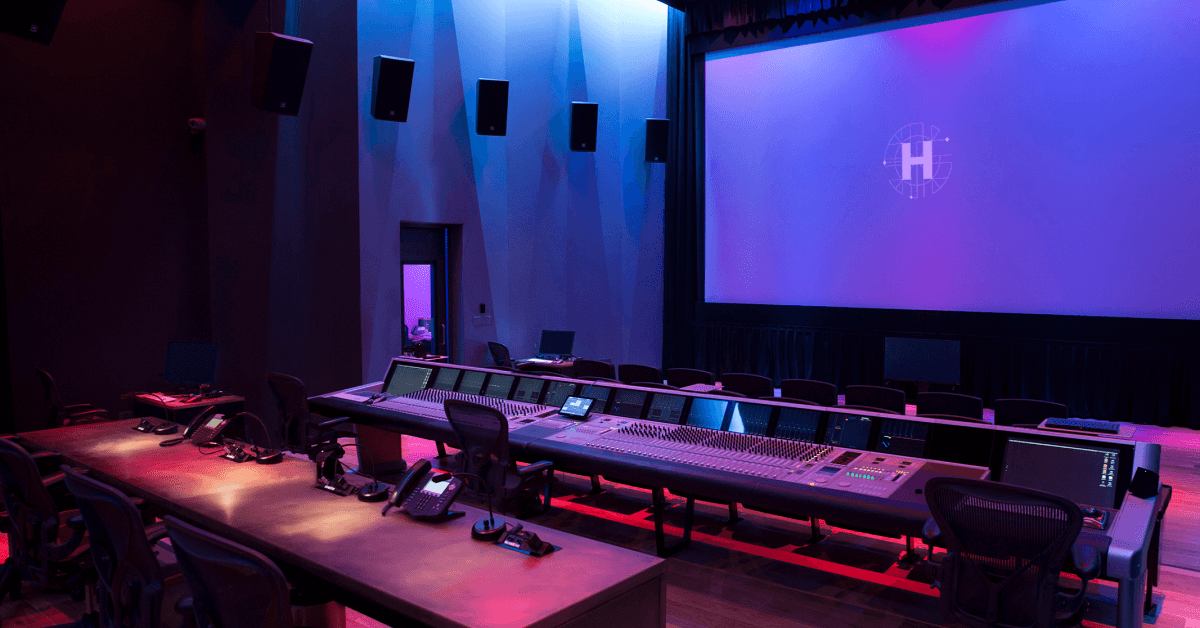Harbor’s Steve Perski details his approach to advertising sound design, his work on a recent GMC spot, and how PSE impacts the editorial process.
In the world of advertising, where the stakes are high and attention spans are short, sound design is an invaluable tool for engaging the viewer, communicating information, and eliciting emotion. But when voiceover, music, and visuals are often equally important, it takes skill and creativity to weave these elements together into an effective call to action. Harbor has been crafting engaging ad spots as well as episodic and feature productions since 2012, counting brands like Tide, Citi, and Goldfish among its advertising clients. According to Creative Director of Commercial Sound Steve Perski, key to Harbor’s success are a proactive mindset, a flexible workflow, and an interdisciplinary team.
Steve Perski - Creative Director of Commercial Sound, Harbor Picture Company
“I think clients are drawn to Harbor because of the holistic approach that we bring,” said Perski. “We try to get involved in the process as early as possible. I always try to see the storyboards and talk to the editor, just to start the ideation process. We do our own production as well, so sometimes we're getting audio while they're shooting and I can be part of the conversation. When we're doing creative editorial, we're constantly talking and trading things back and forth from the start, so they might put together a quick edit and I might do some design that might inform something else they do later on in the edit. Especially with things that are VFX-heavy, you have to work in tandem with the VFX department. Being on the same page with multiple departments under one roof gives us a huge leg up.”
Perski – who oversees all sound design for the company’s advertising clients and leads Harbor’s team of skilled mixers – recently completed designing, editing, and mixing a 30-second spot for the new GMC Sierra AT4X. Perski walked us through his approach to advertising sound design, the process of designing the GMC spot, and how Pro Sound Effects helps Harbor keep delivering quality content.
Sound Design for Advertising
Because commercials exist in a wide range of genres from cinematic compositions packed with sound effects, voiceover, and music to wordless tone pieces meant to evoke a feeling, there’s no one-size-fits-all approach when it comes to sound design. As Perski explains, every client requires a bespoke approach dictated by their particular industry, brand voice, and target demographics.
“Just like every film is different, every brand and every spot is different,” Perski explained. “Some brands come at things from the comedic standpoint, and sound design can play a huge role in that, too. It just depends on the brand and what they're going for. I've worked with many different brands, and everybody wants theirs to feel unique and have its own sonic identity, so I treat every project like a separate film and go into each with a blank slate.”
When aesthetics and messaging goals can vary so much from brand to brand and campaign to campaign, being adaptable is key. With Pro Sound Effects libraries and many in-house recordings at his disposal, Perski takes a maximalist approach with sound design and covers every element to ensure maximum flexibility in the mixing phase.
“I design every little thing as if it were going to be there, and then let the edit dictate which moments we can highlight and where we need to pull back,” said Perski. “It depends on where dialogue falls too. There are times when we get to the mix and someone might say, ‘let's not have the voiceover start things off right away.’ If we have all of these sounds laid out and built already, it's much easier to pull them up, turn them down, mute them, unmute them, or whatever we need to do.”
In addition to the traditional 30- and 60-second formats, Harbor creates six-second short form ads destined for streaming platforms such as YouTube. Perski explained his approach to communicating emotion and information in such a compressed format.
“Especially for automotive, we're trying to give you a sense of the whole campaign in six seconds,” said Perski. “We want to give you the sound of the car, make you feel the power of it, and add the music track. I try not to get too intricate on the six-second spots because it doesn't give you enough time to really play out a whole scene, but I'm adding ambience, vehicle sounds, and a couple of design elements like whooshes or hits depending on the edit. We're not usually putting voiceover on those, so we get a little bit more leeway to push things harder, mix-wise.”
“Everybody wants [their ad spot] to feel unique and have its own sonic identity, so I treat every project like a separate film and go into each with a blank slate.”
Designing Sound for the GMC Sierra AT4X
The recent 30-second spot for the new GMC Sierra AT4X shows the next-generation pickup speeding through a rugged, mountainous environment backed by voiceover from Will Arnett and music by The Roots. As the vehicle deftly climbs a dirt switchback road, we hear the whir and growl of the capable engine, gravel crunching under the wheels, and dynamic whooshes as the truck speeds past. Arriving at a majestic waterfall, the camera then flies through the curtain of water and into a cave, where the AT4X comes to a stop while the drivers take in the spectacle. To craft effective sound design for the spot, Perski began by tapping into GMC’s brand aesthetic and customer base.
“GMC is a brand that has a lot of power behind it, especially these trucks that we're talking about,” Perski explained. “From a sound perspective, we want to give people a sense of what it's like to drive these vehicles. Their market is the outdoor enthusiast type, so we’re striving to show them how far you can push these vehicles. It's not often that you actually get to drive right up to a waterfall, so I wanted to explore what this environment would sound like and how the car would sound driving through it.”
To immerse the viewer and make them feel the power and grace of the vehicle, Perski carefully wove his sound design into the natural breaks in the action as dictated by the edit.
“I want you to feel the shifts in motion, and the easiest way to convey that feeling is to hit the shot changes,” said Perski. “Negative sound has a big impact as well, because you really feel it when things dip out or come back. I'm always cognizant of the music track and dialogue, as well. Especially for this spot, with an iconic song by The Roots, voiceover by Will Arnett, and a pretty dense sound design bed, we have to pick and choose moments to highlight.”
Despite the dense mix, the waterfall flythrough gave Perski a chance to use sound design to its fullest potential. In designing this brief but powerful moment, Perski’s more-is-more philosophy paid off.
“That waterfall moment probably has about 35 sounds,” explained Perski. “There's three beds of ambience, some birds, a slight wind, and a few whooshes that carry us all the way through the waterfall. And then there's a cacophony of water sounds – some I designed as if you heard it almost hit the camera as it went through, and some are just passing through an actual waterfall. There's a few layers of cave ambience, too. For the interior shot at the end, I took what we used for the full waterfall, found a space where it was a little quieter, and used some EQ and compression to give it more of a squished feel. I built it in levels like that because I’m trying to use motion to convey these things in such a short short period of time.”
“Even our video editors are using Pro Sound Effects. They use the web platform a lot and have great things to say about it… it's super helpful that we have access to the same sounds.”
Working with Pro Sound Effects
Every sound designer needs a large library of source material to draw from, and it’s even more important for an end-to-end production house like Harbor. Having used Pro Sound Effects libraries at a previous job, Perski encouraged Harbor to invest in CORE – our flagship library bundle series featuring more than 1.2 million sounds from 160+ libraries created by our award-winning sound artists and recordists.
“I pull so much from Odyssey every day, and the Wu Collection is great, too,” Perski remarked. “I’m constantly using all the Ambisonic libraries for ambiences.”
And it’s not just the sound team using Pro Sound Effects assets – in keeping with Harbor’s interdisciplinary approach, the editorial team has access to the same resources. This enables them to cut a rough soundtrack with the same sounds that Perski uses, enabling the sound and picture departments to build on each other’s work throughout the process.
“Even our video editors are using Pro Sound Effects,” Perski explained. “They use the web platform a lot and have great things to say about it. And because we work in tandem with them, I might be doing the sound design while they're in the edit and we can send things back and forth. I always keep everything they add; I don't cut anything out. Even if we end up losing it in the end, it could inform where we're going, so it's super helpful that we have access to the same sounds.”
In the fast-paced world of advertising, speed is just as important as quality. With ready access to Pro Sound Effects libraries, Perski is able to create engaging and dynamic sound design on short notice.
“I happened to be at our space in LA last week when we put together a new automotive presentation,” Perski recounted. “It had been cut together that day and the editor asked me, ‘Hey, can you sound design this two-minute piece in two hours?’ And I was able to; no problem. I pulled a bunch of the Watson Wu material for the pass-bys because there were a lot of cool, quick cuts. It was a full 5.1 mix for a 50-person theater, and the whole room was rumbling. It was great.”
Get 30-Day Free Trial Access: Empower your creative team with Pro Sound Effects
Dante Fumo is a Midwest-based sound designer, editor, and mixer specializing in independent film and Dolby Atmos mixing. In his free time, Dante composes electronic music and publishes Harmonic Content, a zine about sound.

















